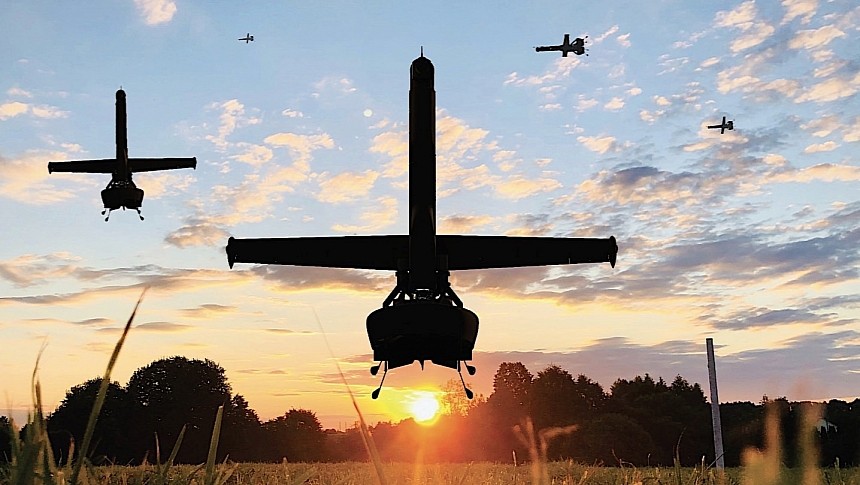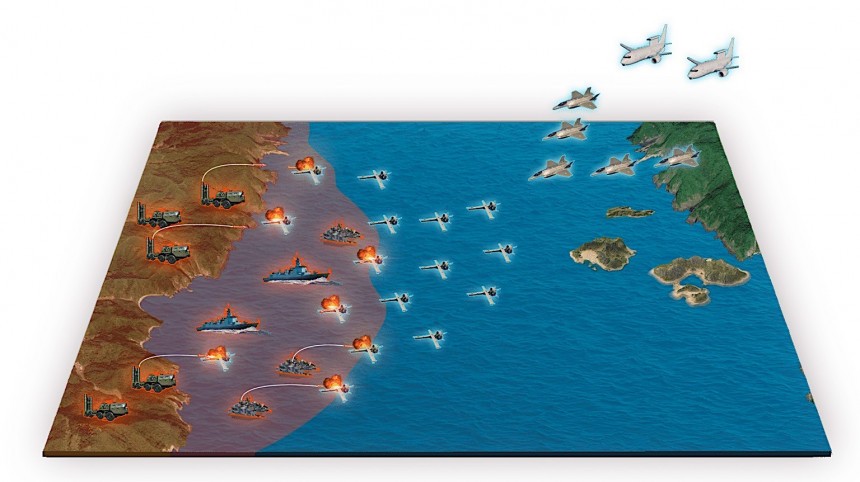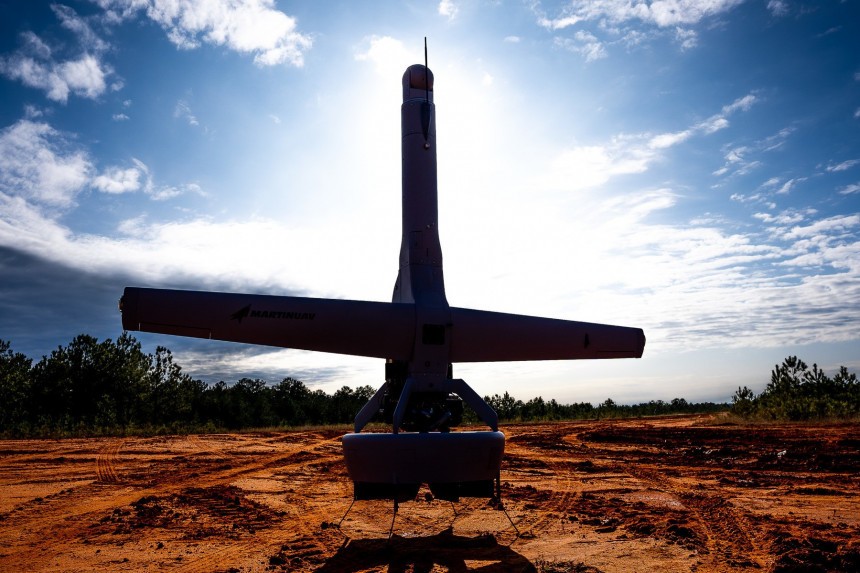Imagine a future when teams of coordinating military drones, acting and reacting on their own accord to changes and challenges on the battlefield, relentlessly pursue their target until it's neutralized. Sounds like something out a movie, right? Wrong. It's a reality our world will experience as soon as next year.
We've already seen the lethality and relentlessness of drones used for military purposes on the battlefields of Ukraine. But most if not all of those assets are working under human control, with operators in constant contact with the weapons telling them what to do and when to do it.
That's not how something called the V-BAT Teams system will work. No, in this case, we're talking about teams of a minimum of four V-BAT drones working together "to autonomously execute missions in electronically contested environments."
Not only that, but they will need no GPS or communications link with the home base to operate, and they will also be capable of responding and adapting to enemy moves, environmental challenges, and even to each other.
The V-BATs are being put together by a company called Shield AI. We're talking about machines 9-foot (2.7 meters) long powered by a single rotor in a ducted fan design. They can reach altitudes of as high as 20,000 feet (6,000 meters), and hover for long periods of time.
Despite their design being unusual, and their capabilities at the top of the food chain, the drones themselves would be a lot less impressive had they been designed to be controlled by humans. But they're not, as governing their decisions and actions will be an artificial intelligence system called Hivemind.
The thing is described as the "world's best AI pilot for aircraft." It is essentially a system meant to work independently from human control, with zero requirements when it comes to GPS signals or waypoints.
In a nutshell, the AI allows each drone to create its own map of the environment using onboard sensors and cameras, and operate based on that. All the Hivemind needs to know is what the mission is, and it will do the rest on its own, without any need for behavioral programming.
The Teams system has been created to "work together in electronic warfare environments and as part of a human-machine team" to enhance a military unit's capabilities and awareness. The company behind the idea promises that the simple deployment of a team of BATs will give squads the combat power of a battalion, or battalions the power of a division.
That is because just four of these things, flying above the battlefield around the clock, can see everything that's happening in an area of 30,000 square miles (78,000 square km). More than that, the drones can track (meaning find, fix, and target) roughly 1,000 different objects at the same time. When the need arises, one BAT can laser the target, and another delivers the kill shot.
Human operators are not completely out of the loop, though, and they'll be in contact with the swarms by means of a mobile control station. That's a briefcase-sized piece of tech that expands into large displays and keyboards that will allow operators to manage V-BAT Teams – an unlimited number of them can be commanded to perform this or that task from the same station.
That sounds both amazing and scary, and Shield AI does little in the way of letting us know what safeguards are in place. Quite the opposite, actually, as the V-BAT Teams will more or less behave like Star Trek's Borg: "when one V-BAT flies, the fleet learns."
Shield AI says that at first the Teams system will be offered as a set of four drones, probably because of the limitations of the Hivemind. But there is a promise that the number will "double annually for the foreseeable future," creating ever-increasing swarms of killer drones.
How big, you ask? Well, the guys working on this are envisioning armies of possibly thousands of such machines flying in sync, doing all they need to do to get the job done, no matter what.
Constant upgrades (quarterly ones for the software and biennial ones for payload) are promised by the company as it seeks to draw in as many operators (read customers) as possible.
The V-BAT Teams system is as of now available for order by interested parties (civilians will not be allowed to buy them, of course), for prices that have not been disclosed. Shield AI expects the drones to start being delivered and serve on the battlefields of the world (of which there seems to be an ever-increasing number, sadly) as soon as next year.
It remains to be seen who deploys the system first and with what effects, but the arrival of the V-BAT Teams could very well be seen as the moment when AI truly took to the battlefield.
That's not how something called the V-BAT Teams system will work. No, in this case, we're talking about teams of a minimum of four V-BAT drones working together "to autonomously execute missions in electronically contested environments."
Not only that, but they will need no GPS or communications link with the home base to operate, and they will also be capable of responding and adapting to enemy moves, environmental challenges, and even to each other.
The V-BATs are being put together by a company called Shield AI. We're talking about machines 9-foot (2.7 meters) long powered by a single rotor in a ducted fan design. They can reach altitudes of as high as 20,000 feet (6,000 meters), and hover for long periods of time.
Despite their design being unusual, and their capabilities at the top of the food chain, the drones themselves would be a lot less impressive had they been designed to be controlled by humans. But they're not, as governing their decisions and actions will be an artificial intelligence system called Hivemind.
The thing is described as the "world's best AI pilot for aircraft." It is essentially a system meant to work independently from human control, with zero requirements when it comes to GPS signals or waypoints.
The Teams system has been created to "work together in electronic warfare environments and as part of a human-machine team" to enhance a military unit's capabilities and awareness. The company behind the idea promises that the simple deployment of a team of BATs will give squads the combat power of a battalion, or battalions the power of a division.
That is because just four of these things, flying above the battlefield around the clock, can see everything that's happening in an area of 30,000 square miles (78,000 square km). More than that, the drones can track (meaning find, fix, and target) roughly 1,000 different objects at the same time. When the need arises, one BAT can laser the target, and another delivers the kill shot.
Human operators are not completely out of the loop, though, and they'll be in contact with the swarms by means of a mobile control station. That's a briefcase-sized piece of tech that expands into large displays and keyboards that will allow operators to manage V-BAT Teams – an unlimited number of them can be commanded to perform this or that task from the same station.
That sounds both amazing and scary, and Shield AI does little in the way of letting us know what safeguards are in place. Quite the opposite, actually, as the V-BAT Teams will more or less behave like Star Trek's Borg: "when one V-BAT flies, the fleet learns."
Shield AI says that at first the Teams system will be offered as a set of four drones, probably because of the limitations of the Hivemind. But there is a promise that the number will "double annually for the foreseeable future," creating ever-increasing swarms of killer drones.
Constant upgrades (quarterly ones for the software and biennial ones for payload) are promised by the company as it seeks to draw in as many operators (read customers) as possible.
The V-BAT Teams system is as of now available for order by interested parties (civilians will not be allowed to buy them, of course), for prices that have not been disclosed. Shield AI expects the drones to start being delivered and serve on the battlefields of the world (of which there seems to be an ever-increasing number, sadly) as soon as next year.
It remains to be seen who deploys the system first and with what effects, but the arrival of the V-BAT Teams could very well be seen as the moment when AI truly took to the battlefield.
















